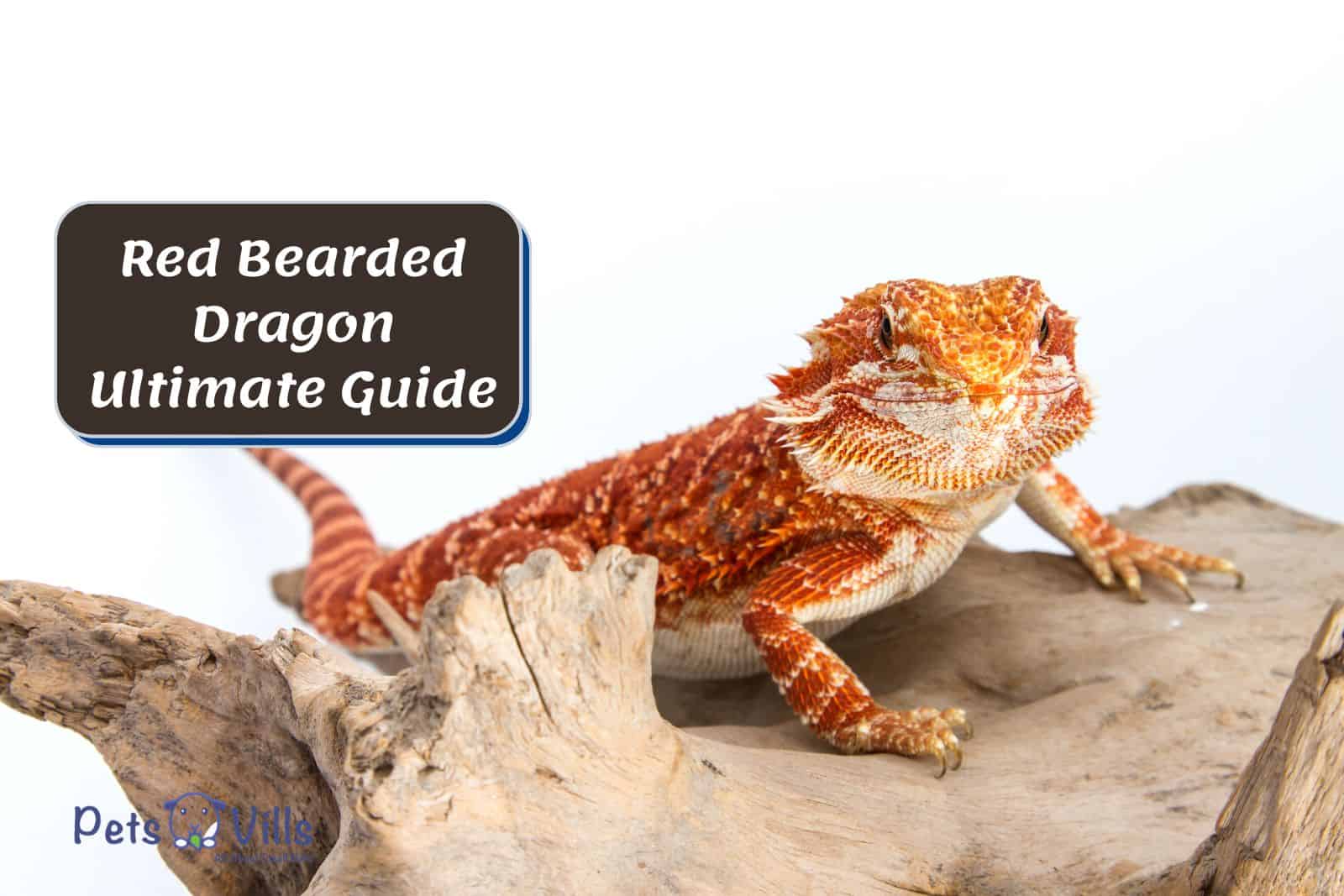Are you fascinated by red-bearded dragons and curious to learn more about these fantastic pet reptiles?
One of my first lizards was a red beardie, so I spent a lot of time researching how to care for them and spoke with many vets and reptile experts.
And today, I’m ready to share my vast experience with you and help you determine if red beardies are the right choice for you.
Just keep reading.
Check: The List of Species of Bearded Dragons
What Are Red Bearded Dragons?
Red bearded dragons are a morph of the common bearded lizard, Pogona vitticeps. While some wild beardies have spots of red, this specific morph is all red.
As a novice reptile owner, I thought all bearded dragons were brown/tan. However, once I gained more experience, I learned about bearded dragon morphs.
Let me share the “secret.”
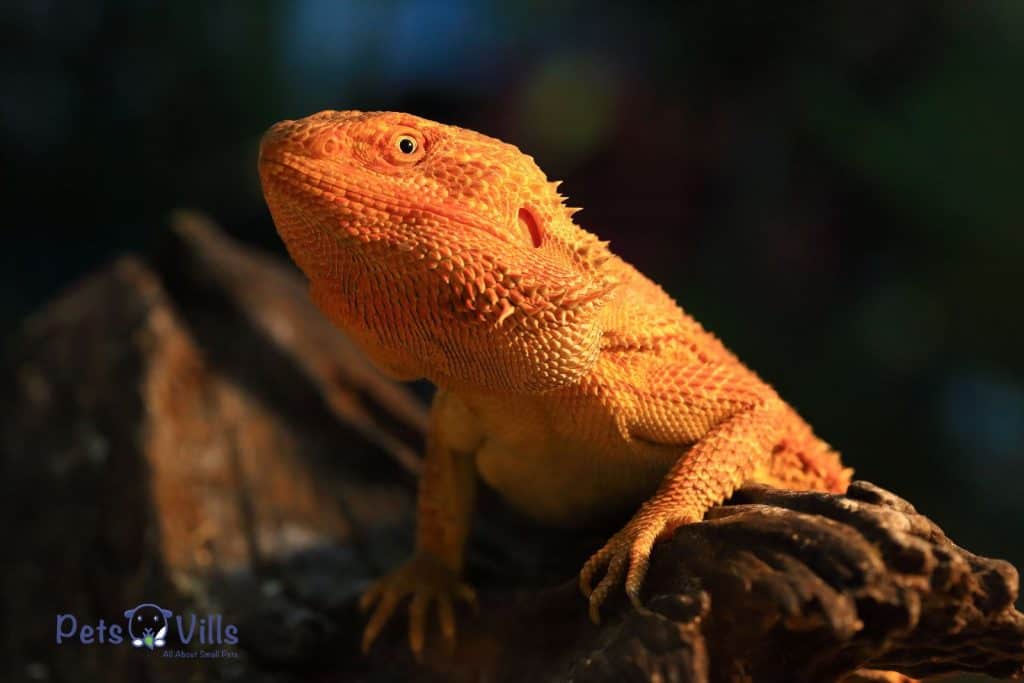
There’s a reason why regular bearded dragons living in the Australian desert are tan or brown with dusty hues. It allows them to hide from potential predators and camouflage when under stress.
Still, natural mutations result in dragons born with different colors, patterns, or scale textures. These don’t survive for long in the wild because they’re easy prey.
Breeders selectively breed adult bearded lizards in captivity to create specific patterns and colors, such as red, yellow, blue, etc. They’re called morphs.
And now, let’s talk about what red-bearded dragons look like and how to tell them apart from common beardies.
Appearance
As the name suggests, red-bearded dragons have red-colored bodies with spiny reptilian scales forming a “beard” below the chin.
Unlike the common beardie, not all red beardies have spikes. For example, a red Leatherback beardie has a smooth back without spikes.
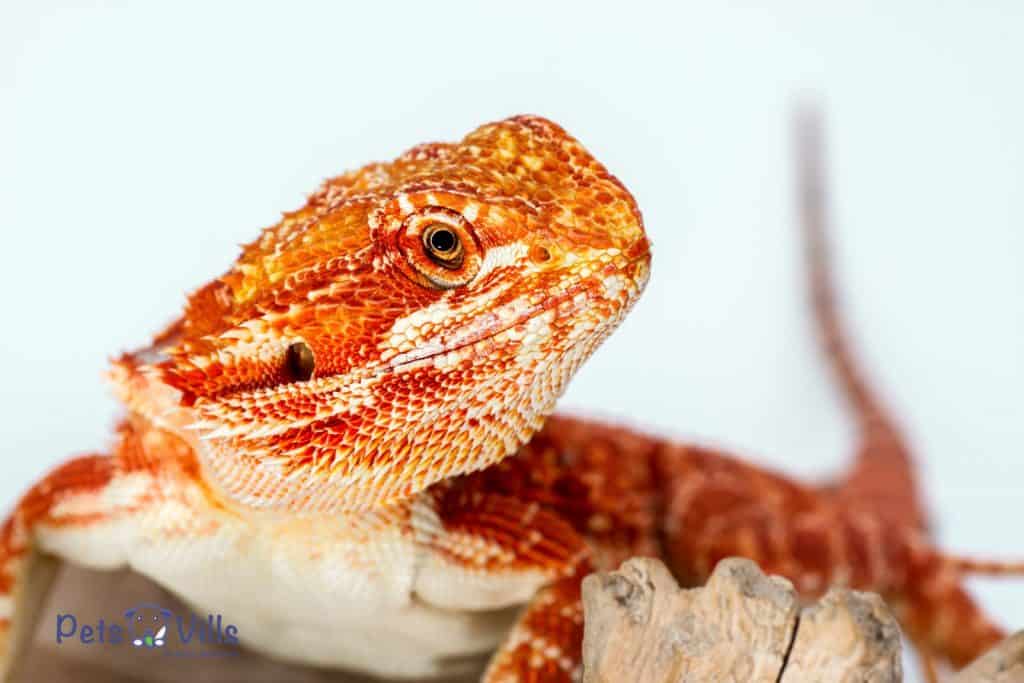
These red lizards also come in shades of red, such as ruby-red, blood-red, or sand fire red. Some shades are very rare and expensive because they’re hard to breed.
So, as long as the bearded lizard has a vibrantly-colored body, you can be sure it’s a red morph, not an ordinary beardie. But what types of red-bearded dragons exist?
CHECK: What Are Fancy Bearded Dragons?
Types of Red Bearded Dragons
Breeders are constantly selective breeding bearded lizards to produce unique color and pattern combinations. So, It’s no surprise that several “types” of red-bearded dragons exist:
- Classic red. It is similar to the common beardie, but its body is red, not tan/brown.
- German Giant bearded lizard. They’re much larger than the standard red beardie.
- Red Lethearback dragon. This type lacks spikes along the back.
- Hypo red leatherback beardie. These dragons produce less melanin, so their color is duller.
- Super red leatherback beardie – lizards with two red genes from each parent.
Also Check: What is a Leatherback Bearded Dragon?
Check this video to see what a red bearded dragon looks like!
Size and Weight
Adult dragons can reach up to 24 inches in length, from nose to tail end, with a weight of up to one pound. Babies are around 3-9 inches and weigh up to 20 grams.
The only exception is the Giant German dragon, which can reach up to 30 inches. However, this is a rare morph, and red German Giants are even rarer. But not unheard of.
Lifespan
Red bearded dragons have six to ten years when raised in captivity. Provide an adequate diet and suitable tank to ensure
Health Issues
According to vets from VCA, “If they are well looked after, with a good diet and proper environment, bearded dragons are reasonably hardy animals.” (1)
Still, red-bearded dragons are prone to the same health issues as normal beardies:
- A diet low in calcium and high in phosphorous puts bearded dragons at risk of developing metabolic bone disease. It causes jaw swelling and leg tremors.
- Parasites. Pinworms can cause weight loss and diarrhea.
- Respiratory infections.
- Mouth rot – a bacterial infection of the mouth that causes thick mucus and swelling
Bearded dragons can also become dehydrated, mainly if you haven’t provided a water bowl. Many owners think that bearded lizards don’t drink water, but that’s not true.
Since they come from a desert environment, beardies mostly hydrate by eating food with high water content and licking raindrops. In captivity, they still need a water bowl for proper hydration.
Take your red-bearded lizard to the vet if you notice sunken eyes, sneezing, eye/nose/mouth discharge, lack of appetite, discoloration, or sudden changes in behavior.
Check out this gorgeous red beardie.
@meleystheredqueen Meleys, The Red Queen 🔥 #beardeddragon #redbeardeddragon #transluscentbeardeddragon #redbeardie #houseofdragons #creaturecradle #beardie #meleys ♬ Pure Imagination – Kathleen
Breeding
If you decide to breed your adult dragons, the female will lay its eggs 4 to 6 weeks after the mating. Provide a suitable lay box (a plastic box with soil works well) and separate the male and female lizards.
Once your dragon lays its eggs, you’ll need to incubate them because adult dragons aren’t the most caring parents. Sixty days after incubating, the eggs should hatch.
Red Bearded Dragon Diet
Bearded lizards are omnivores and can eat a wide range of green vegetables, insects, fruits, and flowers. However, diet requirements change with age:
- Young red bearded dragons need more animal-based protein than plant-based. So, their diet should be up to 80% insects and 20% vegetables.
- Adult bearded lizards require a balanced diet of around 70-75% plant-based food and 25%-30% animal protein (grasshoppers, crickets, mealworms, etc.)
- Red bearded lizards also need calcium and vitamin D3 supplements to avoid metabolic bone disease and calcium deficiency.
Improper diet is one of the main reasons for problems with shedding. And speaking of shedding, it’s vital to know how often your red beardie will shed and how to help them.
Check out what this beardie is eating.
@gzzz1717 Red Bearded Dragon ASMR #dubiaroach #salad #beardeddragon #asmr #eatingshow #fyp #foryou #parati ♬ original sound – GZZZ1717
Shedding
All bearded dragon morphs shed their skin because the keratinized scales don’t stretch. So, they must shed their outer coat to accommodate their growing bodies.
Like common beardies, red-bearded lizards shed in patches. Hatchings shed weekly, juveniles every two-three months, and adult dragons – once or twice a year.
It’s normal for dragons to lose their appetite, appear lethargic, or become irritated because the shedding process takes a lot of energy.
Here is how you can help your beardie shed.
@artemis_the_red_dragon only helping her because she can’t do it herself 😔 #beardeddragon #reptile #shedding #asmr ♬ Relaxing Japanese-style piano song inviting nostalgia – Akiko Akiyama
To help with the shedding, I provide plenty of branches and rocks in the bearded dragon enclosure so my pet can rub against it to dislodge the shedding skin.
More about proper husbandry in a bit. But first, let’s talk about red bearded dragon price.
Cost
Red bearded dragons are a unique type of beardie morph, so they can cost between $200 to $800, depending on the shade, marking, and the bearded dragon age.
You’ll also have to consider buying everything you’ll need to provide a suitable habitat for your pet reptile – tank, heating, humidity meters, proper food, vet visits, etc. It can cost over $1000 for the first year.
And where can you buy red bearded dragons? Let’s find out!
Where to Buy Red Bearded Dragons?
It’s not hard to find red bearded dragons for sale. Many online pet shops offer red beardies, such as Petsmart or Morphmarket.
You can also visit reptile expos. These events host hundreds of breeders with quality stock, allowing you to meet other reptile enthusiasts and get professional advice from breeders.
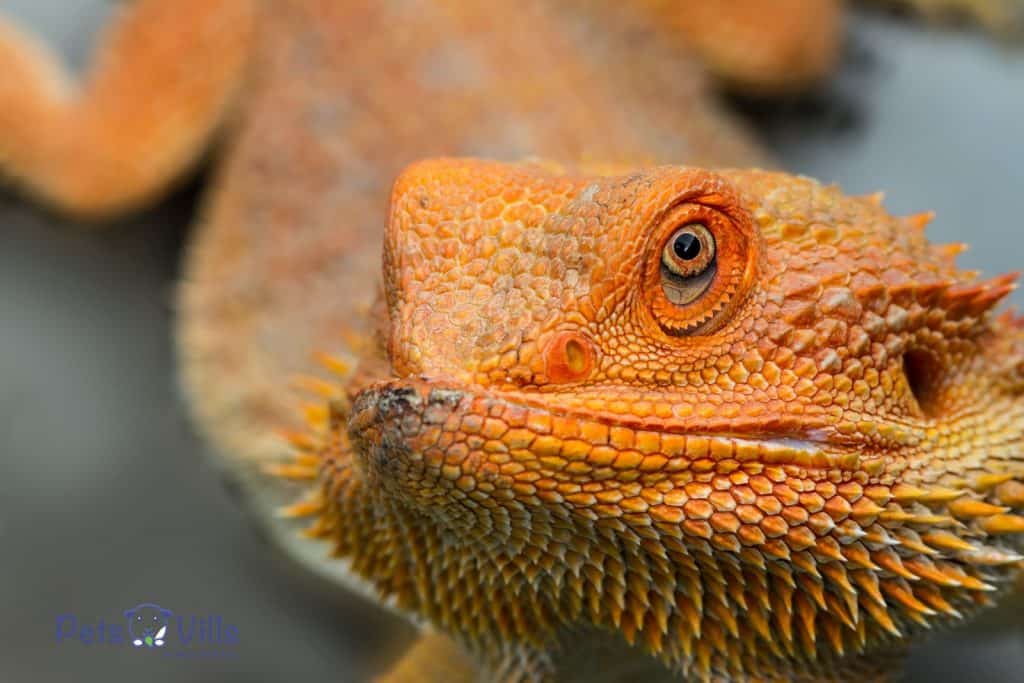
Of course, you can also find reputable breeders online through their websites or by chatting with other reptile owners in forums and social media groups.
I prefer breeders to pet stores because stores often keep multiple beards in one tank, which leads to stress, injury, and sickness.
When adding a new beardie to my vivarium, I inspect the body for signs of injuries, unusual discharge, or missing toes. Avoid animals that look sluggish or unresponsive.
And if you’re considering purchasing a red bearded dragon, you should know how to care for it.
How to Care for a Red Bearded Dragon?
Red bearded dragons are relatively easy to care for, even for novices. You must provide the right tank and maintain suitable humidity levels/temperatures to mimic the dragon’s natural environment.
I’m not going to lie. There’s a learning curve and many things that can go wrong because pet reptiles are more complicated to read than cats and dogs.
Fortunately, once you get used to monitoring the enclosure’s humidity and temperature, your beardie should thrive.
And to help, I’ll walk you through the essential things in caring for a red bearded dragon. And the first important task is setting up your beardie’s tank.
What Do You Need in Your Red Bearded Dragon Tank?
Tank size depends on your beardie’s age. Hatchings can do just fine with a small 10-20-gallon vivarium. However, adult lizards need a 55-gallon aquarium at a minimum.
Vets from PetMD recommend a 75-gallon tank, stating, “an enclosure should be at least three times the beardie’s snout-to-tail length.” (2)
1-Suitable Substrate
And it would help if you covered the bottom with a suitable substrate because beardies often eat it accidentally when looking for food. Here are your options:
- Ceramic tiles. They’re easy to clean, and there’s no risk of your animal swallowing something it shouldn’t.
- Reptile carpet. My top recommendation is cheap, easy to clean, and won’t cause impaction or other health problems.
- Paper towels. They’re popular among bearded dragon owners because they’re cheap and easy to dispose of when soiled.
Some owners also use alfalfa pellets, bark chips, or soil. But I don’t recommend them because they can cause impaction or increase the humidity in the tank.
Also, avoid sand. While sand is one of the most natural substrates since its mimics their natural habitat – the Australian desert, it can cause impaction.
And never use pine or cedar. Cedar or pine shavings are toxic to reptiles.
2-Decorations
You don’t have to go nuts on decorating your red beardie’s tank, but you do need a few essential additions:
- At least two hides at both ends of the tank provide suitable hiding spots for your pet lizards in times of stress. You can use shoeboxes and ceramic pots or purchase coats online.
- Shallow water dish for your beardie to drink or soak. A water dish can also help you increase the humidity level when it’s too low.
- Rocks, branches, and other climbing surfaces
Besides decorations and a suitable substrate, you must maintain the right temperature and humidity.
3-Temperature
Do you know that bearded lizards can’t regulate their body temperature? They’re cold-blooded animals and need an external heat source to provide body heat.
That’s why they need a temperature gradient, and you should provide:
- An overall temperature of 85-90° degrees Fahrenheit
- A cooler side with a temperature of 75 – 80 o F and a warmer side with a temperature of 90 – 100 o F
- A basking spot with a temperature of 88-100°F
Expert Tip: At night, the temperature can be as low as 70°F, according to reptile experts from NC State Veterinary Medicine. (3)
4-Humidity
The RSPCA’s bearded dragon care sheet recommends humidity levels between 30% to 40%, measured on the cool side. High humidity puts your bearded dragon at risk of respiratory infections. (4)
I advise you to purchase a thermometer-hydrometer combo. You can always check on the humidity levels and temperature and adjust them whenever they fall out of range.
5-Light
Besides a hydrometer, another essential tool you need is a UVB bulb, which will allow your lizard to produce vitamin D3. This vitamin is vital for the storage and use of calcium.
Purchase a quality heating lamp and UVB bulbs. The lamp must work 12 hours daily to replicate the reptile’s day and night cycle.
Expert Tip: Check the output of the UVB bulb every few months and replace it when the output decreases too much.
Once your tank is ready, the other important factor is providing proper food and keeping your lizards hydrated.
Red Bearded Dragon Feeding
Captive-bred bearded dragons need food with a calcium to phosphorus ratio of at least 2:1, such as collard greens, mustard greens, bok choy, cabbage, kale, watercress, etc.
Other safe vegetables include leek, radish, okra, squash, basil, bell peppers, etc. Suitable fruits are blueberries, bananas, apples, strawberries, mango, peach, and more.
Avoid celery, mushrooms, oranges, lemons, chives, garlic, iceberg lettuce, eggplants, and avocados.
When you’re feeding insects, you should gut-load them. Gut-loading means you provide the insects nutrition-rich food for a day before giving them to your pet lizard.
This way, your red beardie gets plenty of essential vitamins and minerals.
Remember that young red bearded dragons need more animal-based protein (insects) than vegetables and fruits.
But how often do I need to feed my red-bearded lizards? It depends on its age. Hatchings and juvenile lizards need several daily feedings, while you can provide adults once daily.
Supplements
Even if you feed your red beardie a balanced diet, your pet reptile needs calcium supplements to avoid metabolic bone disease and other calcium-related problems.
You should sprinkle your lizard’s food with calcium powder without vitamin D3 twice a week. Use calcium powder with vitamin D3 twice or thrice a week.
However, be careful not to overfeed your red-bearded lizards with calcium supplements. It can cause various problems, including renal failure and bone deformation.
Bathing
Bearded dragons need a bath once or twice a week. It’s a great way to increase your lizard’s hydration level and bond with your pet.
Check this video to see how to bathe your red bearded dragon without getting bitten!
Some owners also mist their bearded dragons to ensure proper hydration, but it’s a bit of a controversial topic. Talk to your vet if misting is suitable for your pet reptile.
Cleaning the Enclosure
It would help if you cleaned your red bearded’s tank daily to remove old food and excrement. Do a complete cleaning and disinfection every month or so.
Special Care
According to studies, bearded lizards with reduced scalations lose water faster than normal dragons. So if you have a red leatherback beardie, you must keep an eye on its hydration.
A good hydration routine includes bathing your dragon, misting, and providing a bowl of fresh water.
Leatherback dragons also lack scales along their back. They can be more sensitive to heat and prone to injuries in this area.
Check out this cool video on how to take care of your beardie.
@jessicasanimalfriends For an hour long care guide check out my YouTube channel 😌 #beardeddragon #beardie #beardeddragoncare #reptile #reptiles ♬ _Cute – Gabe Lost
Are Red Bearded Dragons Good Pets?
Red lizards make great pets because they’re easygoing and don’t mind humans, even tolerate them. They aren’t aggressive without a good reason and have moderate care needs.
Beardies also get along well with kids and can be a great way to teach your children about responsibility and how to care properly for an animal.
Still, lizard takes a bit more time and effort than cats or dogs. You must gut load the live insects to ensure your pet has a balanced diet.
Moreover, sometimes you do everything by the book, and it’s still hard to maintain the proper temperature or humidity level in the enclosure.
But you don’t have to worry about getting in the early hours of the morning to take your pet for a walk or fill their bowl with food.
And you can bond with your pet reptile with a few easy tricks.
How to Bond with a Red Bearded Dragon?
It’s easy to get your red beardie to like you by making it associate your presence and scent with positive things, such as:
- Bathing. Many beardies love bathing time and enjoy soaking in lukewarm water.
- Feed your beardie by hand.
- Interact with your pet lizard as much as possible and provide it with toys.
- Let your beardie explore by leashing it and taking it on a walk.
Check out these simple tips on how to bond with your pet.
@blackthorn_dragons Reply to @deskwench Bonding with your Beardie #bonding #cutepets #beardeddragon #reptilesoftiktok #reptilekeeperlife #reptilelover ♬ Sunroof – Nicky Youre & dazy
Also Read: Things You Should Know About Albino Beardie
FAQs
Are Red Bearded Dragons Friendly?
Yes, red-bearded lizards are friendly, easygoing, and docile. They don’t mind when you pick them up and handle them.
Are Red Bearded Dragons Poisonous?
No, the bearded lizard’s venom isn’t toxic to humans. However, if you get bitten, you should wash the wound well and watch out for signs of infection.
What Is the Rarest Bearded Dragon Color?
Completely black-bearded dragons are the rarest. Blue, purple, and some shades of red are also rare and unique.
How Long Do Red Bearded Dragons Live?
Bearded lizards live around ten years in captivity. However, some lizards can live up to 15 years with proper care and a balanced diet.
What Can I Feed My Red Bearded Dragon?
You can feed your adult red-bearded lizard vegetable matter, fruits, flowers, and insects. The best food for beardie dragons has a calcium to phosphorus ratio of 2:1.
Conclusion
Red bearded dragons are an excellent choice if you love reptiles and want a pet that requires moderate care.
The most important thing is to keep the temperature and humidity as close as possible to the bearded lizard’s natural habitat and look for signs of illness.
What do you think about red bearded dragons? Have you ever cared for one? Share your experience in the comment section.
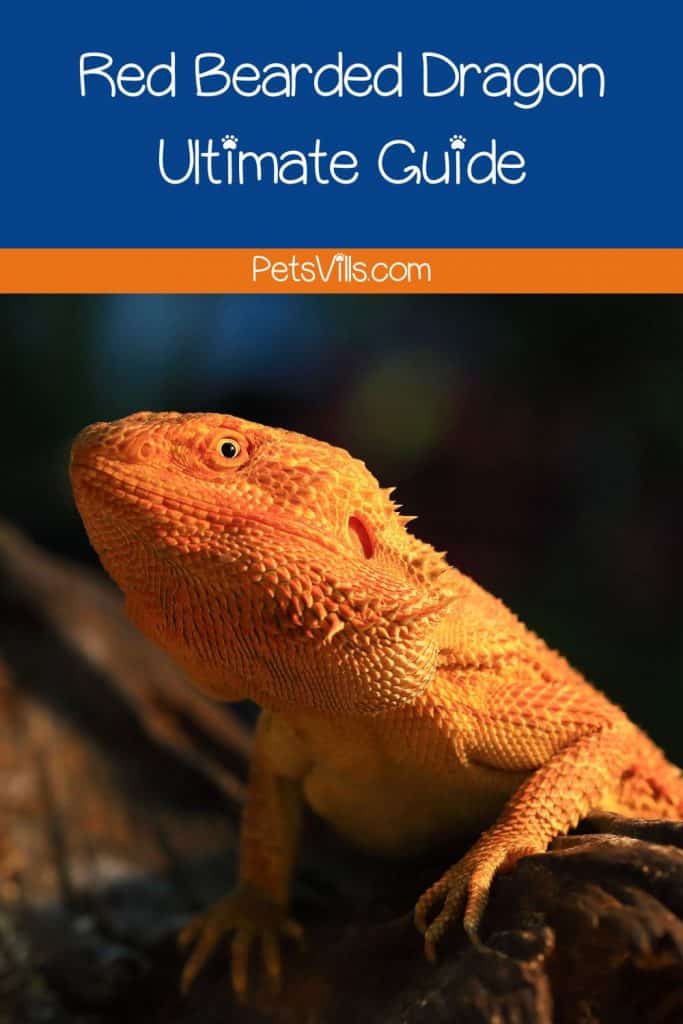
Resources:
- 1. Axelson R. Bearded Dragons – Diseases. vca_corporate. Published 2009. https://vcahospitals.com/know-your-pet/bearded-dragons-diseases
- 2. Bearded Dragon Care 101. www.petmd.com. https://www.petmd.com/reptile/bearded-dragon-care-101
- 3. Caring for Your Pet Bearded Dragon. https://cvm.ncsu.edu/documents/caring-for-your-bearded-dragon/
- 4. Bearded Dragon CARE SHEET ENVIRONMENT. Accessed September 22, 2022. https://www.rspca.org.uk/documents/1494939/0/Bearded+Dragon+Care+Sheet+%28PDF+350KB%29.pdf/151bb6df-1c35-a484-6de8-bffed4985abf?version=1.0&t=1556100899951&download=trueB).pdf
Grigorina grew up surrounded by animals – dogs, cats, cows, goats, sheep, and horses and that has shaped her into what I am today – a crazy cat lady who always has a place for one more cat (or a dog). She has two female cats – Kitty and Roni, and two tomcats – Blacky and Shaggy, but she also feeds her neighbors’ cats when they come for a visit. I just can’t say no to them. Follow her on FACEBOOK AND INSTAGRAM
Read her latest articles HERE
Learn more about her

